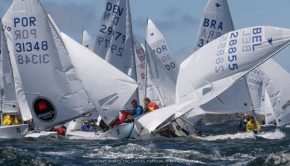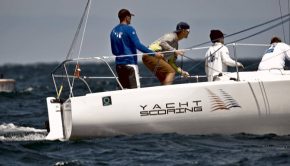How Modern Technology is bringing Sailing to the Masses
Published on August 19th, 2015
When Scuttlebutt started in 1997, the internet was fairly new and we were the primary media to share sailing news. The earth has taken a few spins since those early days, with technology now allowing sailing to be shared on many different levels.
How an event is shared has become a question that organizers must now decide. However, most every option requires either expense or valued volunteers, so it is equally important when asking the ‘how’ is to ask the ‘why’.
In this report by media agency Breeze Studio, Danielle Berclouw provides an update on how far technology has come in sharing the sport…
Imagine seeing ‘Team Telefónica’ getting smashed by giant waves as they blast through the Southern Ocean in 40+ knots (2011/2012 Volvo Ocean Race). Or round-the-World sailor, Jean Pierre Dick talking you through an imminent roaring 40’s squall, with building winds and a tell-tale darkened sky looming ahead.
Incredible? Sure! The last decade has seen monumental changes take place, in terms of how the story of a race is told. It has now become crucial for event organisers to utilise all the new technology available: drones, digital, live footage and video – From the Corinthian to the commercial; from coastal challenges to offshore battles – it’s evident that everyone can jump onboard..
One, two, three… ACTION!
Miriam Torres, former America’s Cup press officer and Yachting World España editor-in-chief agrees: “In the 15 years I have been involved in sailing media, there have been some incredible innovations: Not only with the rise of social media and high-tech smart phones, but also real game changers like the Volvo Ocean Race’s on board reporter.”
This crew member, whose sole task is to deliver fans at home fly-on-the-wall documentation, has not only brought a whole new dimension to spectators, but has played a key part for the Volvo Team, media wise. The press and public get professional level footage, images, quotes and stories in real-time, and one only has to see the increase of media figures of the past few years to conclude that his has had a booming effect on the audience of this nautical mile marathon.
The Vendee Globe, Extreme 40 and America’s Cup all stream live broadcasts of the action as it happens: spectacular wins and dramatic capsizes, collisions and crashes. You name it, you can see it. Live.
“Another breakthrough improvement” adds Miriam “is the LiveLine graphics system in the last America´s Cup, providing graphics to accompany the live footage, all of which has allowed first-time fans to really experience the race.”
The software won an Emmy award for its extraordinary technical innovation, whose aim was to give people the opportunity to better apprehend the ins and outs of sailing. And of course, the more the non-sailing spectators recognise, the more they will want to follow.
At last year’s edition of the World Yacht Racing Forum, Sir Keith Mills, Deputy Chairman of the London Olympic Games organising committee, emphasised the fact that competitive sailing is difficult to understand for the non sail-savvy, so it needs to become easier to grasp.
Drone on
With the high-definition close-up aerial shots that drones are able to capture, as opposed to the view a helicopter can give, it’s no surprise to see many great drone video’s go viral on social media sites such as Facebook. Pigeon Vision, dreamed up by ex-super yacht crew member Justice Bentz, continues to show us original footage, and with nearly 2.5 million views in less than two years has driven sailing drone coverage to new heights.
Think a high speed moth screaming past the screen filmed at such close range you almost feel like you could tap the sailor-over-the-side on the shoulder. Boldly, albeit rightly, one of their Facebook posts simply states: “We’re going to change sail boat racing history”
Everyone can be a reporter
Photos and videos can get uploaded to the various social sites instantly in a time where also your side line spectator could be the one publishing that photo of a silky-smooth spinnaker drop or high-adrenaline video which ends up going viral. Which makes you wonder if fans have now become journalists and whether a reporter has to be double fast because someone, out there, may have just shot that winning video and will no-doubt upload it to YouTube before you know it.
The world is watching
A further key-player in making a hard to follow and technical sport both engaging and accessible are the live tracking sites and apps such as Trac Trac. Although the technology behind the system is advanced and complex, the use of it is easy, accessible and intuitive. During last June’s Superyacht Cup, the site saw people the world over, wanting to track who was chasing whom, and at what speed. Together with the images and videos, they made for a fascinating viewing package holding the attention of thousands of fans at a time.
Another interesting turn is the Extreme Sailing Series’ production of “stadium” type racing. This global grand-prix event has revolutionised the inshore-sailing scene with its traffic stopping, city-centre-action, featuring high performance catamarans and top level sailors. The free to enter public race village allows fans to experience the combat up close while the sailors hear the roar of the crowd. Their figures have proved explosive with 1 million views reached on YouTube in 2011 and a 26% increase in global media value, up to a whopping €35.1million for 2013.
The America’s Cup, also aims to be more of a stadium spectacle, with nearly a quarter million spectators in Portsmouth for the World Series event in July. The 2013 Cup has been called “The greatest comeback in sports history”, evident in the fact that more people watched the first race of that edition than all of the previous America’s Cups combined. Sir Ben Ainslie commented last June that “for the first time in my career, non-sailors were coming up to me, saying they watched those races every night and were hooked by the speed of the boats”. Again this year the cup organisers are concentrating on making it more of a mainstream sport and getting the public involved, pushing ‘The Auld Mug’ into a postmodern place.
Blue skies ahead?
Sports are being evaluated by whether they can reach and engage a global audience. From million-dollar campaigns, to regatta’s organised by local yacht clubs, events are now able to bring sailors, spectators and media a unique action-packed sailing experience. With the evolution of technology and communication having improved so massively over the years it’s not only possible to send content back from the boats but also to track a fleet by seconds or get live video even from the remotest spots in the middle of the Southern Ocean.
Costs have come down for cameras and mixing and editing equipment making it easier to send live transmission from on board. Also photographer Jesús Renedo, one of Spain’s top sailing photographers mentions computer hard drives and memory cards costing less than films and laboratory- work, especially if you shoot a lot.
And showing the world those feats of sailing prowess and human endeavour naturally offer sponsors a cost efficient way to put out a powerful message reaching multiple markets around the globe. And if it’s good for the sponsors it’s good for the event itself as the continued contributions of those commercial partners play a crucial part in the growth of the sport.
With so much images and footage to put out there the challenge lies now within the filtering of this input and on how to stand out from your competitors. Nevertheless, no-one can argue that this new ‘theatre-style’ sailing is not a big step forward for competitive sailing and a very exciting development indeed.









 We’ll keep your information safe.
We’ll keep your information safe.